Feeling Disorganized & Overwhelmed
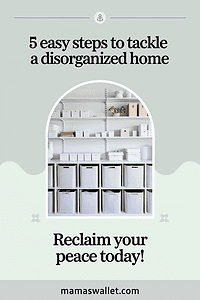
Do you feel like your home is constantly in chaos, no matter how hard you try to keep things organized?
It’s easy to feel overwhelmed when your to-do list seems never-ending and the clutter keeps piling up.
But don’t worry—you’re not alone, and there is a way out of the mess.
I’ll share 7 simple steps to help you regain control and turn your disorganized home into a peaceful sanctuary.
I remember the days when just getting out the door on time felt impossible. The clutter in my home mirrored the clutter in my mind, and I knew something had to change.
Through trial and error, I discovered that a few small changes could make a big difference.
Action Steps
- Prioritize your tasks—Identify the most critical tasks and tackle them first.
- Declutter one room—Start small and see the immediate impact of a clutter-free space.
- Simplify your systems—Use easy-to-maintain organization methods to keep things tidy.
- Take action now—Handle tasks as soon as they arise to avoid procrastination.
- Build good habits—Establish daily routines that support a peaceful, organized home.
Why Disorganization Happens
Did you know that disorganization is often more than just a messy home? For many people, it’s a sign of deeper challenges, like Adult ADHD.
This condition can make it harder to focus, manage tasks, and keep your space tidy.
Understanding the connection between ADHD and disorganization can help you tackle clutter more effectively.
Inattention, impulsiveness, and hyperactivity are common symptoms of ADHD that can lead to a disorganized home.
Difficulty focusing might mean unfinished projects and piles of clutter.
Acting on impulses can result in acquiring more items than you need, creating chaos in your space.
Restlessness might make it hard to complete organizing tasks, leaving your home feeling overwhelming.
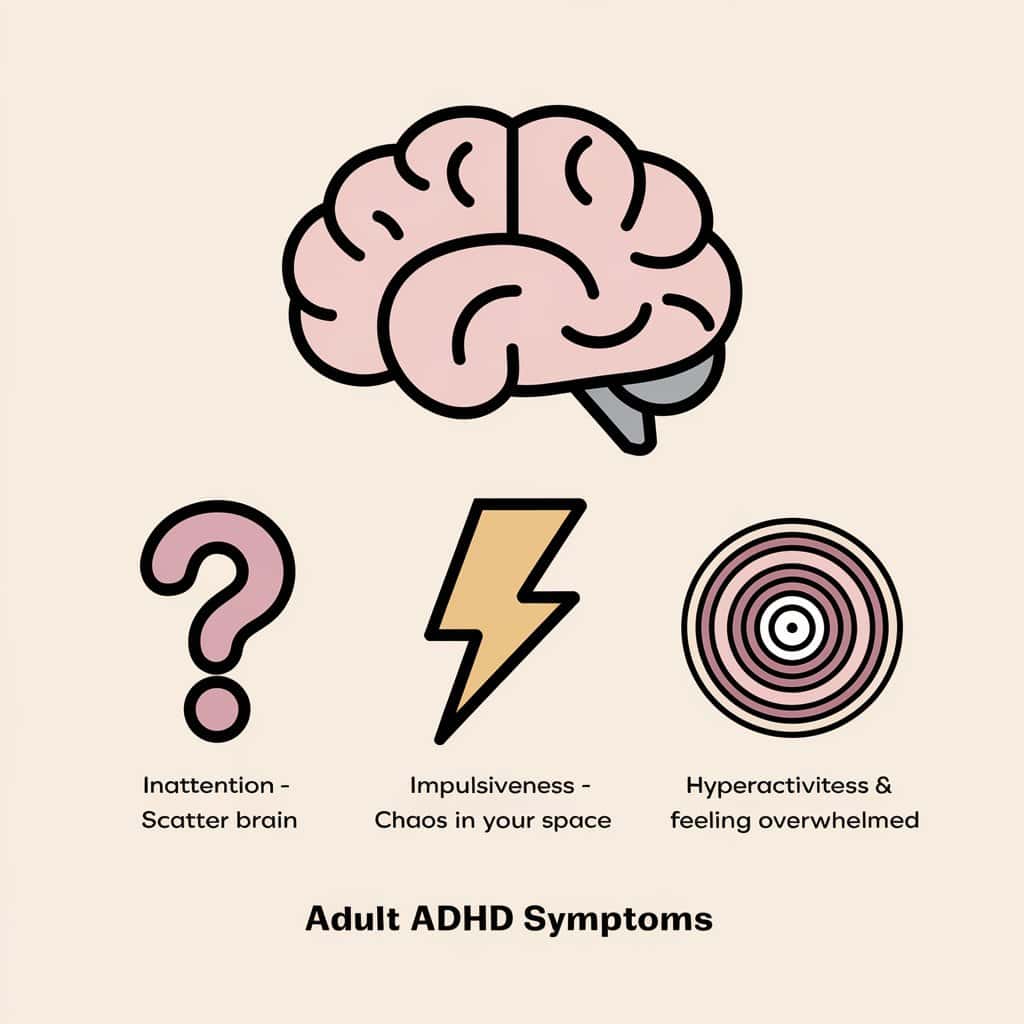
I used to think my struggle with keeping things in order was just a lack of effort, but realizing that ADHD played a role changed my approach.
By addressing the root causes, I was able to find better ways to manage my home and reduce the stress that clutter brings.
If you suspect that ADHD might be contributing to your disorganization, consider exploring resources and support options.
It’s not just about tidying up—it’s about understanding why it’s hard to stay organized in the first place.
To find out more go to the ADAA website and get information, resources, and find help.
Step 1: Prioritize Your Tasks
Staying organized isn’t a one-time task; it requires consistent effort. It’s easy to leave dirty dishes in the sink or let unopened mail pile up, but these small habits can quickly turn into big clutter.
The Importance of Prioritization
Keeping your home tidy means making a conscious decision to handle tasks as they come up, rather than putting them off.
For example, I used to leave my makeup and hair tools scattered across the bathroom counter every morning.
It wasn’t until I made the effort to put everything away after each use that I noticed a big difference in how clean and organized my space felt.
It takes extra effort, but the reward is a calm, clutter-free home.
Actionable Tips for Prioritizing
Here are some simple habits that can make all the difference:
- Wash dishes right after a meal instead of letting them sit in the sink.
- Sort mail immediately as it arrives to prevent paper clutter.
- Put things away after using them, whether it’s makeup, tools, or clothes.
- Tidy up daily—a little bit of effort each day keeps the mess from building up.
These small, consistent actions will help you maintain an organized home without feeling overwhelmed.
Step 2: Declutter One Room
Less can truly be more when it comes to keeping your home organized. Often, we accumulate items that don’t add value to our lives, and this excess leads to clutter.
By embracing a minimalist approach, you can simplify your space and make it easier to maintain.
Start Small to See Big Results
Start by focusing on one room at a time. For example, declutter your bedroom by getting rid of clothes you no longer wear, or clear out your bathroom cabinets by tossing expired products.
The idea is to keep only what you use and love.
I found that creating a capsule wardrobe—a small collection of versatile clothing—made it much easier to keep my closet organized.
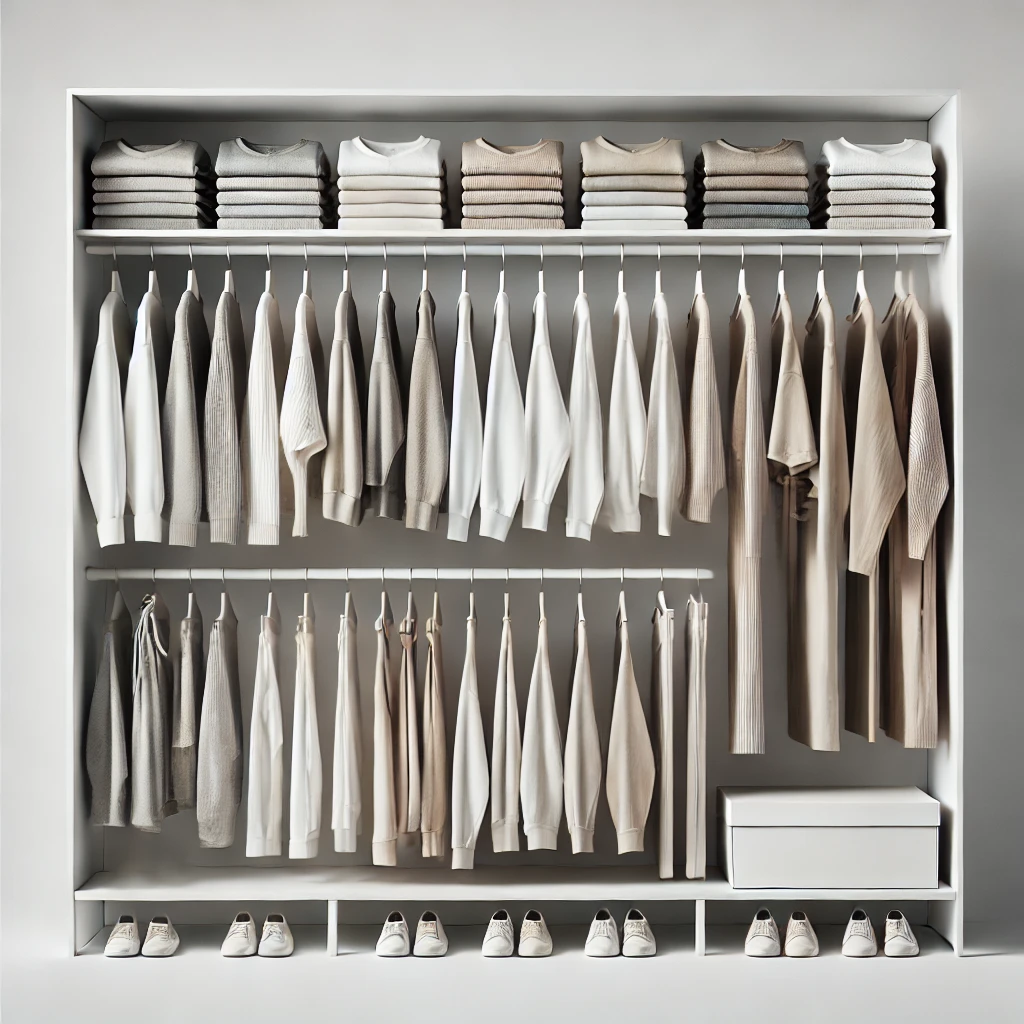
With fewer clothes to manage, I spend less time tidying up and more time enjoying my space.
Decluttering Techniques
Here are a few tips to get started with minimalism:
- Declutter by category: Focus on one type of item at a time, like clothes, books, or kitchenware.
- Keep only what you need: Ask yourself if each item adds value to your life.
- Create a capsule wardrobe: Simplify your closet by keeping only versatile, essential pieces.
- Embrace simplicity: The fewer items you have, the easier it is to stay organized.
By reducing the number of items in your home, you’ll find that staying organized becomes much simpler.
Minimalism isn’t about getting rid of everything; it’s about keeping what truly matters.
Step 3: Simplify Your Systems
When it comes to organizing your home, the simpler your systems, the better.
Complex organization methods might look impressive, but they’re often hard to maintain in the long run.
Instead, focus on creating straightforward solutions that make it easy to stay organized.
For example, using hooks by the door for coats and keys, or placing a basket on the counter for mail, can make a big difference.
Why Simple Systems Work
These simple tools ensure that everything has a place, reducing clutter and making it easier to keep your home tidy.
I used to try elaborate storage systems, but I found that the simpler solutions were the ones that really stuck.
By keeping things easy and accessible, I’m more likely to put items away, and my home stays organized with less effort.
Easy Systems to Implement
Here are some simple tips to keep your home organized:
- Use hooks for everyday items like coats, bags, and keys.
- Designate a spot for mail and other papers that come into the house.
- Choose easy-to-maintain systems that don’t require a lot of upkeep.
- Keep frequently used items within easy reach to avoid clutter.
By keeping your organization methods simple, you’ll find it much easier to maintain a tidy home.
Remember, the goal is to create systems that work for you, not against you.
You May Also Like: 8 Time Management Mistakes You Are Making As A Stay At Home Mom.
Step 4: Take Action Now
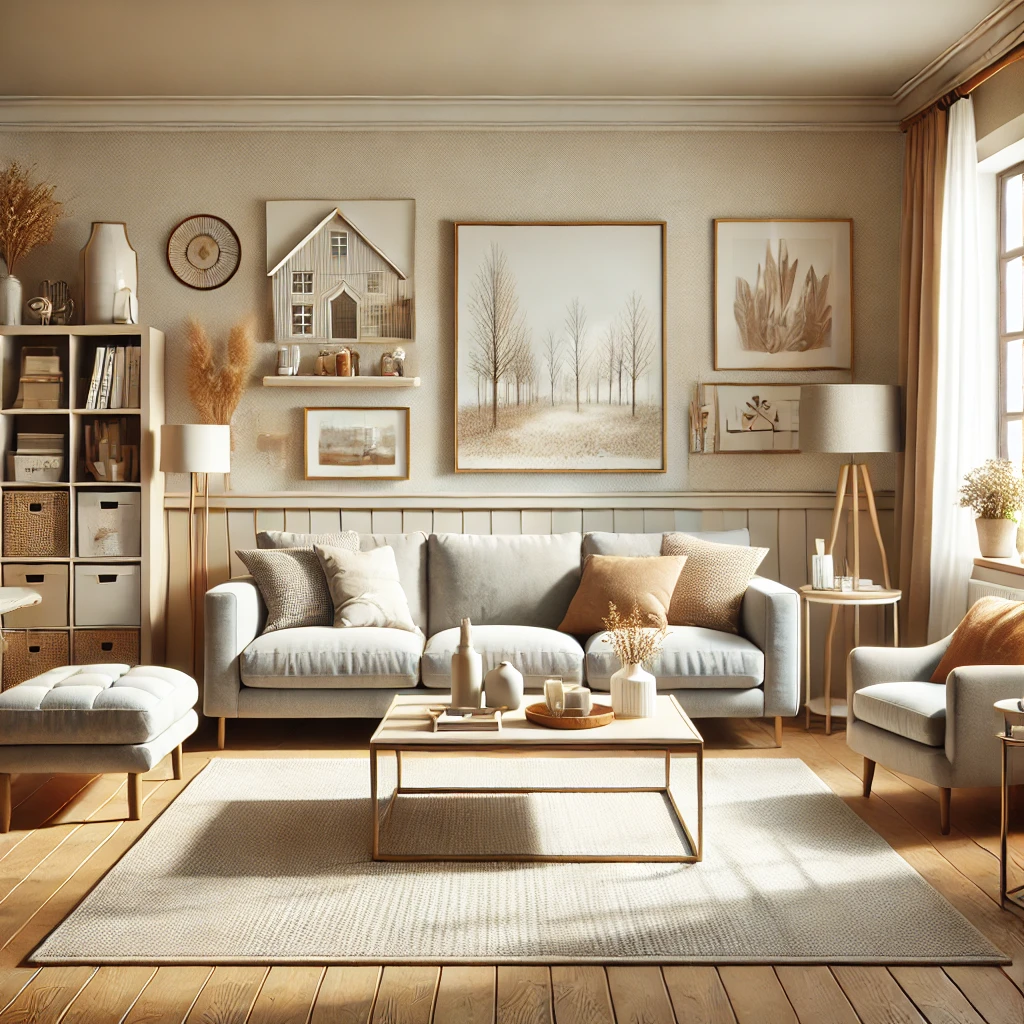
The Cost of Procrastination
Procrastination is the enemy of a tidy home. It’s easy to see a mess and think, “I’ll deal with that later,” but delaying things only allows clutter to build up.
The key to keeping an organized space is to handle things as soon as they come up.
For example, instead of leaving laundry in the basket or dishes in the sink, make it a habit to take care of them right away.
By doing this, you prevent tasks from piling up and turning into overwhelming chores.
I used to let small things slide, thinking I’d get to them eventually.
But I realized that by tackling them immediately, I was able to keep my home much more organized with minimal effort.
How to Take Immediate Action
Here are some tips to fight procrastination and keep your home tidy:
- Handle small tasks immediately: Don’t let dishes, laundry, or clutter sit—deal with them as they arise.
- Set a timer: Give yourself a short time limit to complete a task, making it less daunting.
- Adopt a “do it now” mentality: The quicker you address a task, the less likely it is to turn into a bigger problem.
- Break down larger tasks: If a job feels overwhelming, break it into smaller, manageable steps.
Fighting procrastination and addressing tasks as they come up, you’ll find it much easier to maintain a clean and organized home.
Step 5: Build Good Habits
One of the keys to keeping an organized home is creating good habits. Organized people don’t just tidy up once and forget about it—they include organization into their daily routines.
The Power of Daily Habits
Creating consistent habits will make it easier to keep your home tidy without feeling overwhelmed.
For example, making your bed every morning, doing a quick 10-minute tidy-up each evening, or putting items back in their designated spots after use are small actions that can have a big impact.
These habits help prevent clutter from building up and make it easier to maintain order.
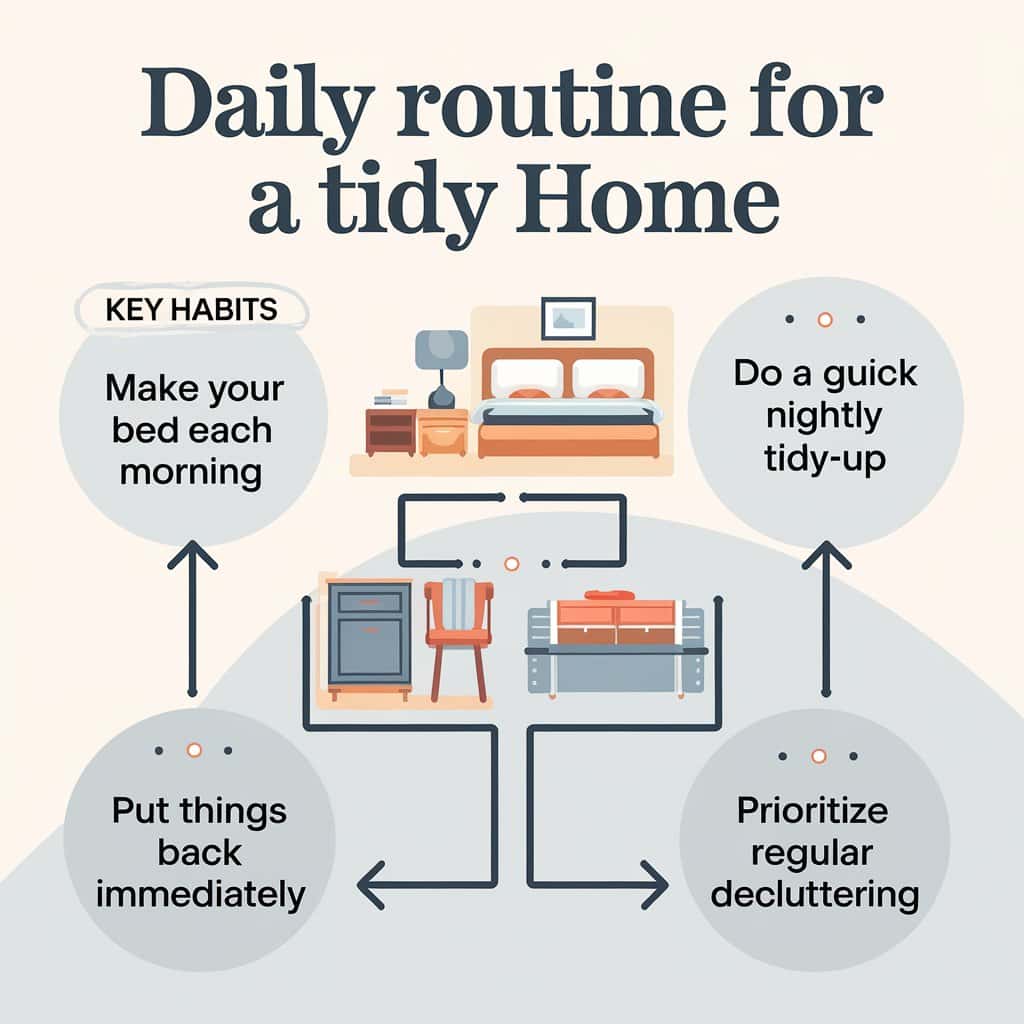
When I started creating these habits, I noticed a change in how organized my home felt.
It became less about big cleaning sessions and more about maintaining a standard of tidiness every day.
Habits to Start Today
Here are a few habits to start today:
- Make your bed each morning: It sets a positive tone for the day.
- Do a quick nightly tidy-up: Spend 10 minutes each evening putting things in order.
- Put things back immediately: Return items to their designated spots after use.
- Prioritize regular decluttering: Schedule time each week or month to declutter and reorganize.
By building these habits into your daily routine, you’ll find that staying organized becomes second nature, and your home remains a calm and clutter-free space.
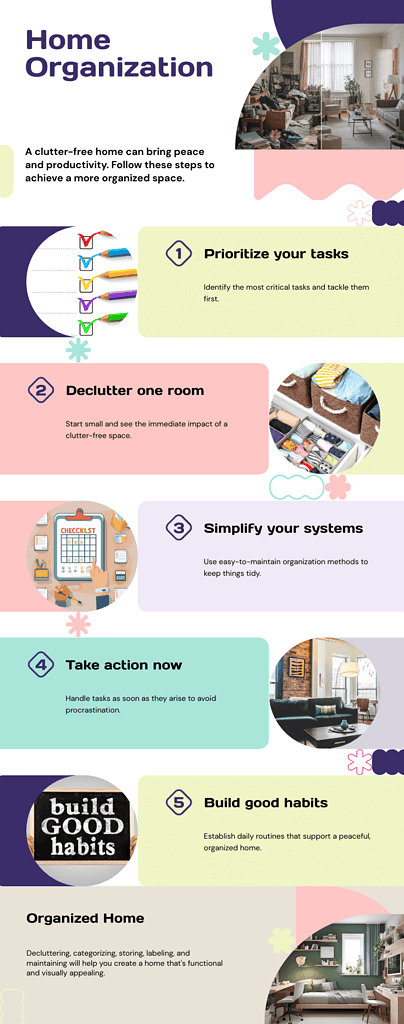
Action Steps Recap
Let’s quickly recap the five steps to tackle a disorganized home and reclaim your peace:
- Prioritize Your Tasks: Start by identifying the most important tasks and handle them first.
- Declutter One Room: Focus on one room at a time, and enjoy the immediate benefits of a clutter-free space.
- Simplify Your Systems: Implement easy-to-maintain organizational methods that make staying tidy effortless.
- Take Action Now: Don’t let tasks pile up—address them as soon as they arise to keep clutter at bay.
- Build Good Habits: Establish daily routines that support ongoing organization and reduce stress.
From Disorganized Home To Reclaimed Peace
Creating and maintaining an organized home is a journey that requires patience and consistency.
By taking these small steps and incorporating them into your daily life, you’ll find it much easier to keep your home a place of peace and tranquility.
Remember, you don’t have to do everything at once. Start with just one step today and watch how even the smallest change can make a big difference.
You have the tools you need—now it’s time to put them into action and enjoy the calm and order you deserve. You’ve got this!